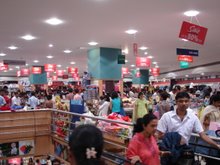Indian Retail sector grapples with high space cost
| Adequate supply at most locations provide little relief, while most fear overcapacity by end of 2007. |
| Most retailers in India feel that real estate in India is too expensive for creation of a viable retail sector. |
| A study released by KPMG on the Indian retail sector says that 91 per cent of respondents said real estate prices in the country was overpriced and only 9 per cent felt it was affordable. |
| Respondents said prices were unacceptably high despite adequate supply of retail space in major destinations. |
| In fact, 66 per cent of the respondents said retail space supply was adequate while 33 per cent of the respondents complained about a shortfall in supply. |
| The report said availability of quality retail space was a critical enabler for the anticipated growth of modern retailing in India. |
| The pressing issue was the cost of real estate that retailers were having to pay, and most of them felt that it was overpriced. |
| The fact that real estate was overpriced had been highlighted by those outside the retail sector as well, including the Reserve Bank of India and leading housing finance and construction industry gurus. |
| The preferred form of retail real estate was property acquired through long-term leases. |
| A small group of retailers however used a mix of owned and leased real estate space while others preferred to go in entirely for owned areas. |
| Another problem with the real estate sector was bottlenecks in select locations, where users and retailers had to wait for some years to get suitable space at proper locations to set up their stores. |
| In most locations however, the availability and supply of real estate was was adequate. |
| The report, which was backed by FICCI, pointed out that all the major retailers would be looking to double the area under retail space for their new stores in the next three years. |
| This meant ensuring a steady and adequate supply of fresh space. |
| The demand faced a common problem across all Indian cities: they were choking as rapid urbanisation far outstripped infrastructure needed to service this growth. |
| The core areas in most cities, or the central business districts, appeared to be incapable to deliver the real estate space needed. |
| The retail sector would gravitate towards malls and approximately 68 million square feet of mall space was expected to come up by the end of 2007. |
| The curious fact was that as much as 70 per cent of the respondents were worried that there would be over-capacity and excess supply if all the malls opened as planned. |
| Some of the respondents felt that overcapacity would be felt most intensely in pockets like Gurgaon while some others feared excess supply across all the major cities in the country. |
| One of the reasons for this apprehension was that that large number of malls planned for commissioning by the end of 2007 would not be able to get the necessary anchor tenants needed to get them off the ground. |
| The report indicated that the current total built-up area under malls was 22 million square feet with Delhi and the national capital region accounting for 31 per cent followed by the Mumbai and greater Mumbai area at 30 per cent, with Chennai, Bangalore and Pune accounting for 6 per cent each and Hyderabad and Kolkata for 3 per cent of the total national area under malls each, the balance 15 per cent being represented by malls in other urban clusters. |
| By end-2007, the expected total built-up area was expected to be 90 million square feet, with the northern region accounting for 39 per cent, the western for 33 per cent, the south for 18 per cent and east for 10 per cent. courtesy:moneycontrol.com |


No comments:
Post a Comment